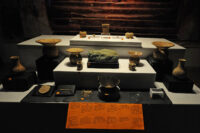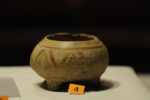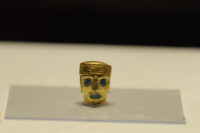 A group of 45 pre-Inca ceremonial objects have been discovered at the archaeological site of Tiwanaku, western Bolivia. The objects include ceramic vessels and statuary, stone knives, bottles, a gold head with blue stone yes and lips that may have represented a deity and the remains of animals including fish, camelids and birds. They are at least 1,500 years old, and may date as far back as the 4th century.
A group of 45 pre-Inca ceremonial objects have been discovered at the archaeological site of Tiwanaku, western Bolivia. The objects include ceramic vessels and statuary, stone knives, bottles, a gold head with blue stone yes and lips that may have represented a deity and the remains of animals including fish, camelids and birds. They are at least 1,500 years old, and may date as far back as the 4th century.
Fifteen of the pieces were unveiled at a press event on Tuesday.
The Ministry of Culture, organizer of the event, specified in a technical report that the find is “made up of many components or ceremonial supplies” and that “it will allow to establish the ritual and ceremonial system that was deployed during the beginnings of Tiwanaku.”
The archaeological pieces “tell us that we are here in Tiwanaku, sitting in a gold mine of knowledge and information, not only important for us, but for the whole world,” declared Bolivian President Luis Arce, invited to the event.
 The artifacts were discovered during an excavation last year in the Temple of Kalasasaya about a foot under the surface. The temple was built by the Tiwanakota culture in what is known as the Tiwanaku III Phase (375-750 A.D.). According to Julio Condori, director of the Tiwanaku Center for Archaeological, Anthropological and Administration Research, these artifacts are the most important find since the monumental edifices of Tiwanaku were rediscovered in the 1800s.
The artifacts were discovered during an excavation last year in the Temple of Kalasasaya about a foot under the surface. The temple was built by the Tiwanakota culture in what is known as the Tiwanaku III Phase (375-750 A.D.). According to Julio Condori, director of the Tiwanaku Center for Archaeological, Anthropological and Administration Research, these artifacts are the most important find since the monumental edifices of Tiwanaku were rediscovered in the 1800s.
 Located in the Andes about 45 miles west of La Paz near the southern bank of Lake Titicaca, Tiwanaku was the dominant empire in the Andean region before the rise of the Inca. Its political, religious, cultural and economic influence stretched from what is now the border with Ecuador to the north to central Chile/northwest Argentina to the south. It rose to prominence in the first three centuries A.D. and became hub of trade in the region. By the 6th century, it was the largest urban center in the region. A sophisticated network connected town in western Bolivia, northern Chile, southern Peru and northwestern Argentina, moving raw materials to Tiwanaku’s whose crafts guilds created manufactured goods for export over the same routes.
Located in the Andes about 45 miles west of La Paz near the southern bank of Lake Titicaca, Tiwanaku was the dominant empire in the Andean region before the rise of the Inca. Its political, religious, cultural and economic influence stretched from what is now the border with Ecuador to the north to central Chile/northwest Argentina to the south. It rose to prominence in the first three centuries A.D. and became hub of trade in the region. By the 6th century, it was the largest urban center in the region. A sophisticated network connected town in western Bolivia, northern Chile, southern Peru and northwestern Argentina, moving raw materials to Tiwanaku’s whose crafts guilds created manufactured goods for export over the same routes.
Tiwanaku society collapsed around the 11th century. Ceramic production ceased around 1000 A.D. and within a few decades of that most urban centers in the empire were abandoned. Its sphere of influence splintered into tribal chiefdoms until the Inca conquest in the 15th century.